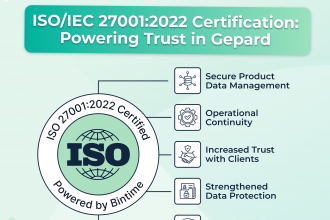eCommerce Product Story: Definitions, Key Elements, And Best Practices
A good product story can communicate the value of the goods you sell and distinguish it among competing models. Storytelling forms a bridge between the media that describe a particular item and a customer’s vision.
People grow up listening to stories, immersing themselves in a fantasy, and becoming its hero. This ability translates into different aspects of our life. In terms of eCommerce, product storytelling provides emotional engagement that often results in better sales.
But what’s a good story and how to create one? Find out from this article the basic definitions, key elements, and best practices.
What Is Product Story In eCommerce?
Product Story Examples From Famous Brands
Let’s illustrate storytelling with some product story examples from popular brands.
Macy’s ID Ideology Product Story
ID Ideology creates men’s activewear exclusively for Macy’s. But what’s so special about yet another brand that creates casual clothing? It leans into the scenario of accepting all athletes, whether amateur or professional – big boys and adults – and you can see the same reflected in their social media campaign. That is while most other brands focus on actual pros or the idea of seeming a pro brand like, say, GymShark.
Here’s one of their items, for example:
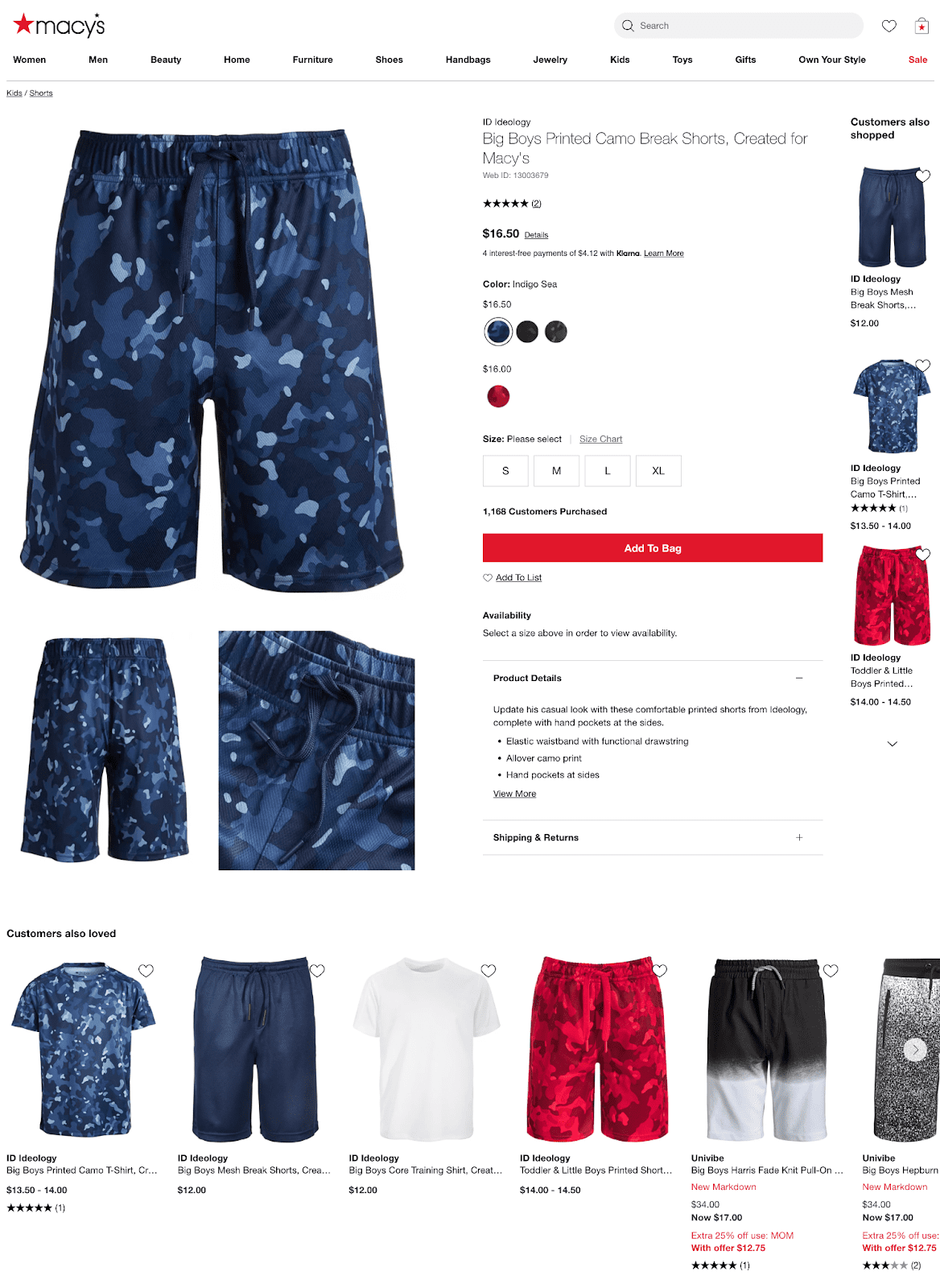
This is a pair of shorts “created for Macy’s” – this supports the exclusivity of the item. If you look at the details, you’ll also discover a language that is in line with the comfort and flexibility of athleticwear. It’s exclusive to Macy’s customers but will suit any buyer who’s interested in active hobbies or simply comfy clothes.
H&M Product Story
H&M has set on a sustainability course since 2021, which is a huge goal for the mass market. Now, you’ll see new drops featuring items made from sustainable materials, which means that you can continue buying from a favorite brand but also become part of the eco-movements. The new brand motto is “Be a fashion recycler!”
Here’s how this translates into a product page:
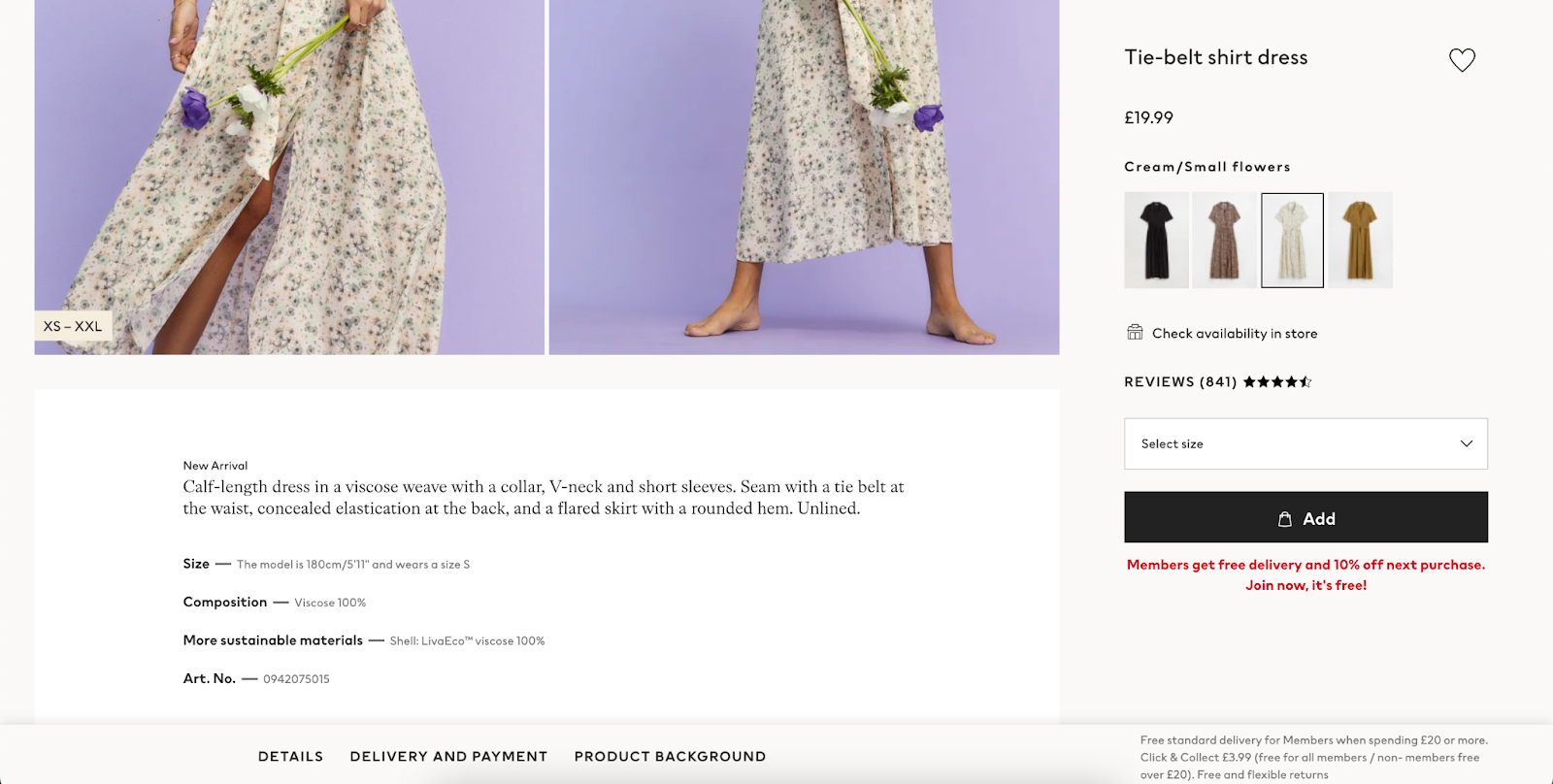
From the description, you’ll find out that the dress—that has a nature-related print, by the way—is made from LivaEco trademarked material. A quick Google search will tell you that this viscose is sourced from certified sustainable forests. There’s also a Product Background tab that can tell you more about H&M’s new mission statement:
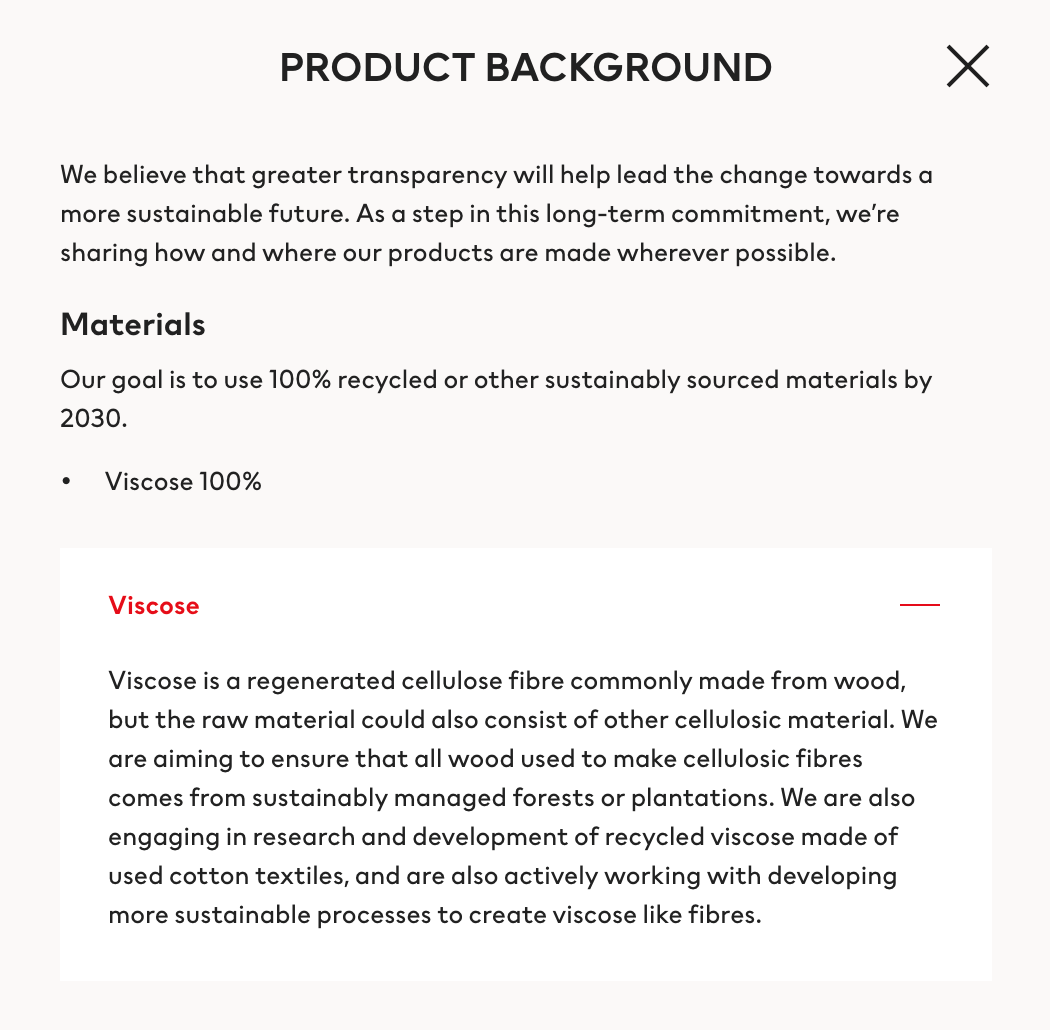
Nike Product Story
Nike’s all-famous motto “Just Do It” can mean anything to anyone – just get up off the couch and go for a walk, just start reading a new book, and just change your habits. And the brand will tag along with “light and comfy” language, like on this page for a pair of running shoes.
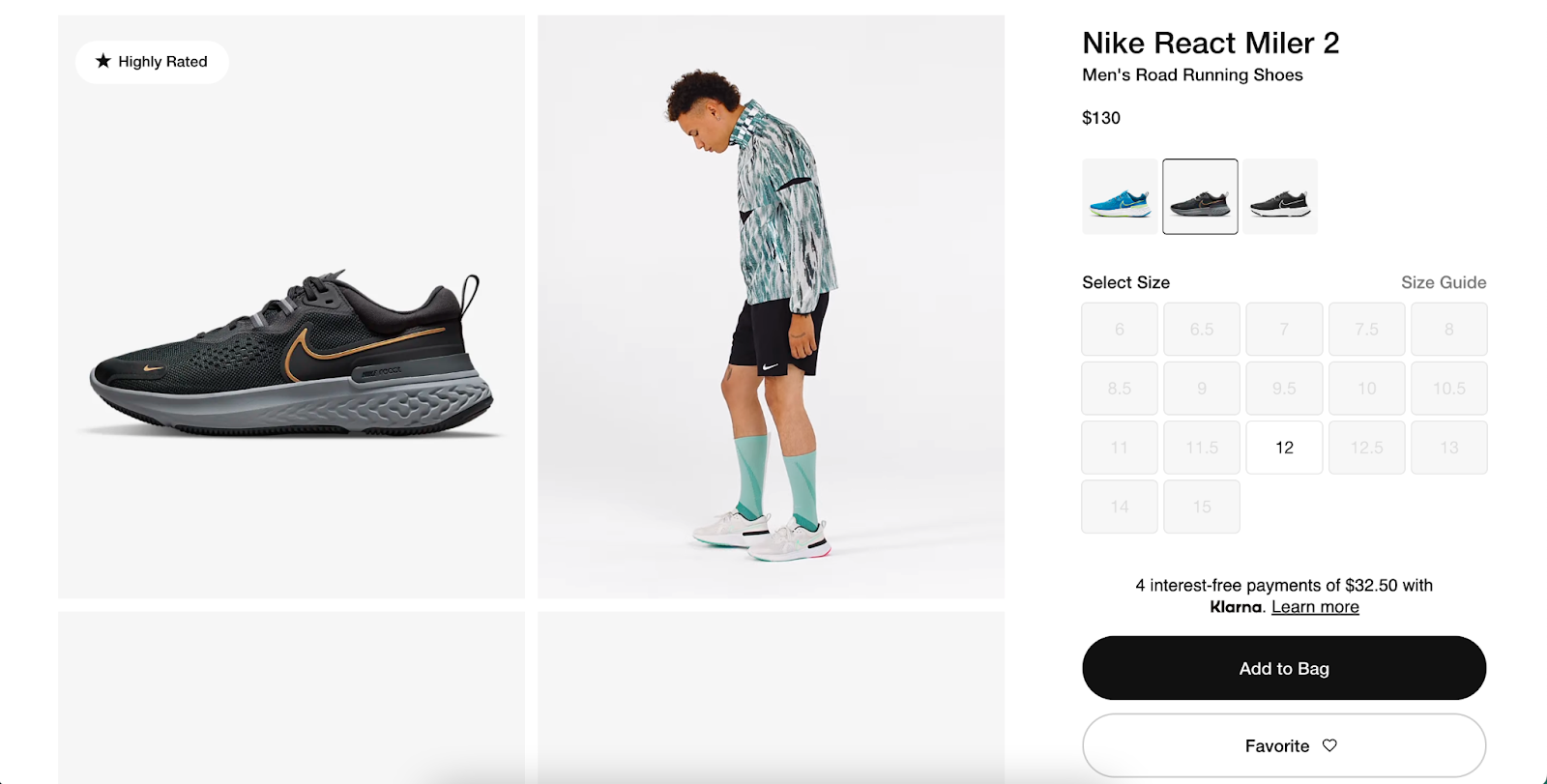
The title reflects its purpose, and if you click on the product description, you’ll see descriptors that associate it with the feeling of comfort and support. It explains the shoes’ value to customers from different angles. It’s also relatable to people who are trying to make running a daily habit.
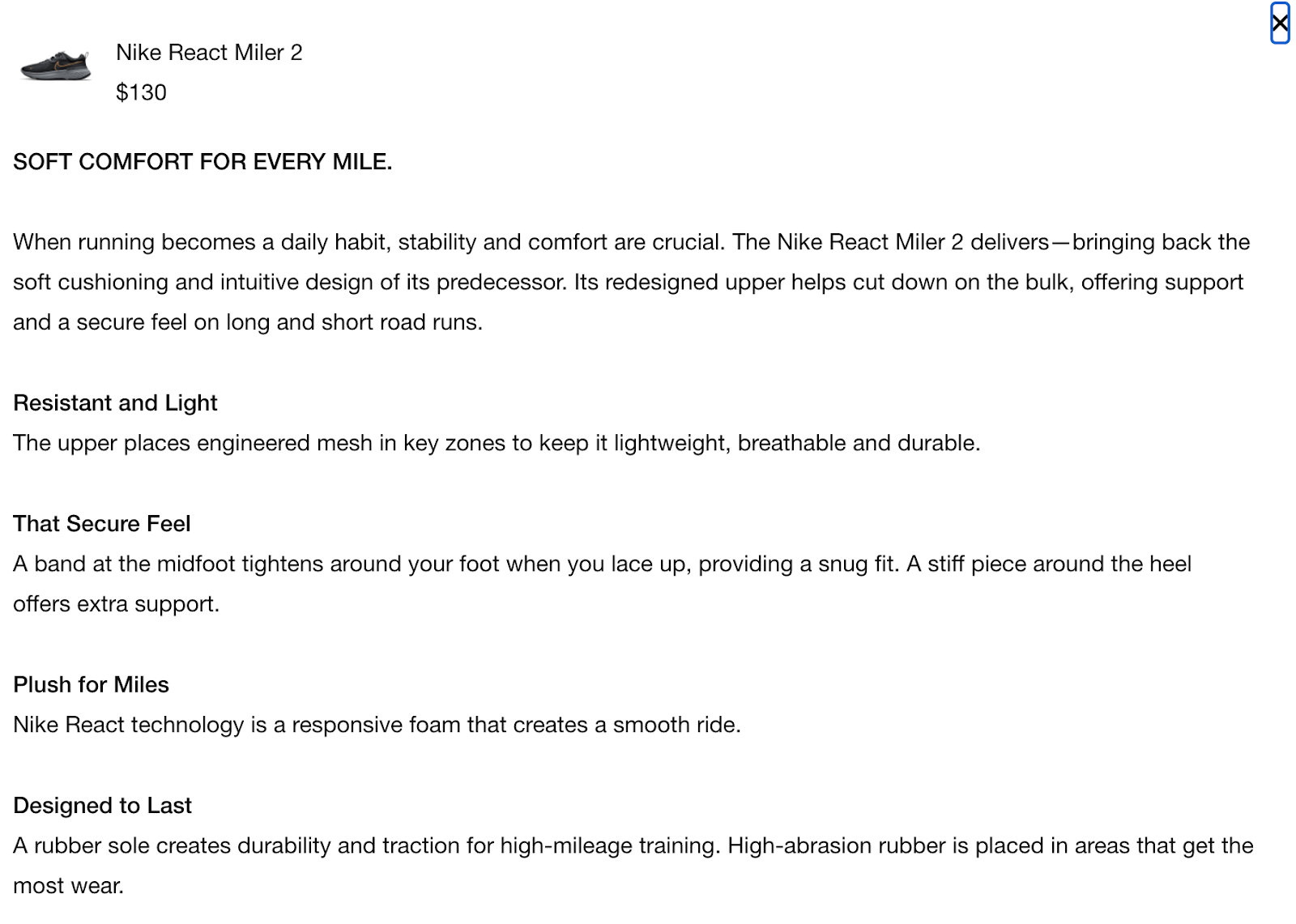
What Is A Product Narrative?
A product narrative is a way in which a story is presented. While a story, in simple terms, is recounting a series of events, the narrative explains how we should perceive what happened, and attributes certain values to a situation.
In terms of eCommerce, this means presenting your merchandise in a way that makes customers desire it, making your brand magnetic, and teaching your employees to speak the same language as the goods you offer.
Product Narrative Examples From Famous Brands
It may be easier to understand what it is based on some product narrative examples. Let’s explore a couple of big brands and how they narrate their tale.
Apple’s Product Narrative
Apple is a narrative in itself. It is the reason people queue for hours to get the new phone model right after its launch. This is because they aren’t buying an object, they’re paying for the experience that the new phone provides.
Look at the iPhone 13 Pro, for example. The page establishes the hero in the introduction – “Oh.So.Pro.” It tells what feelings the new features should ignite and shows its best assets. The whole page is also highly visual.
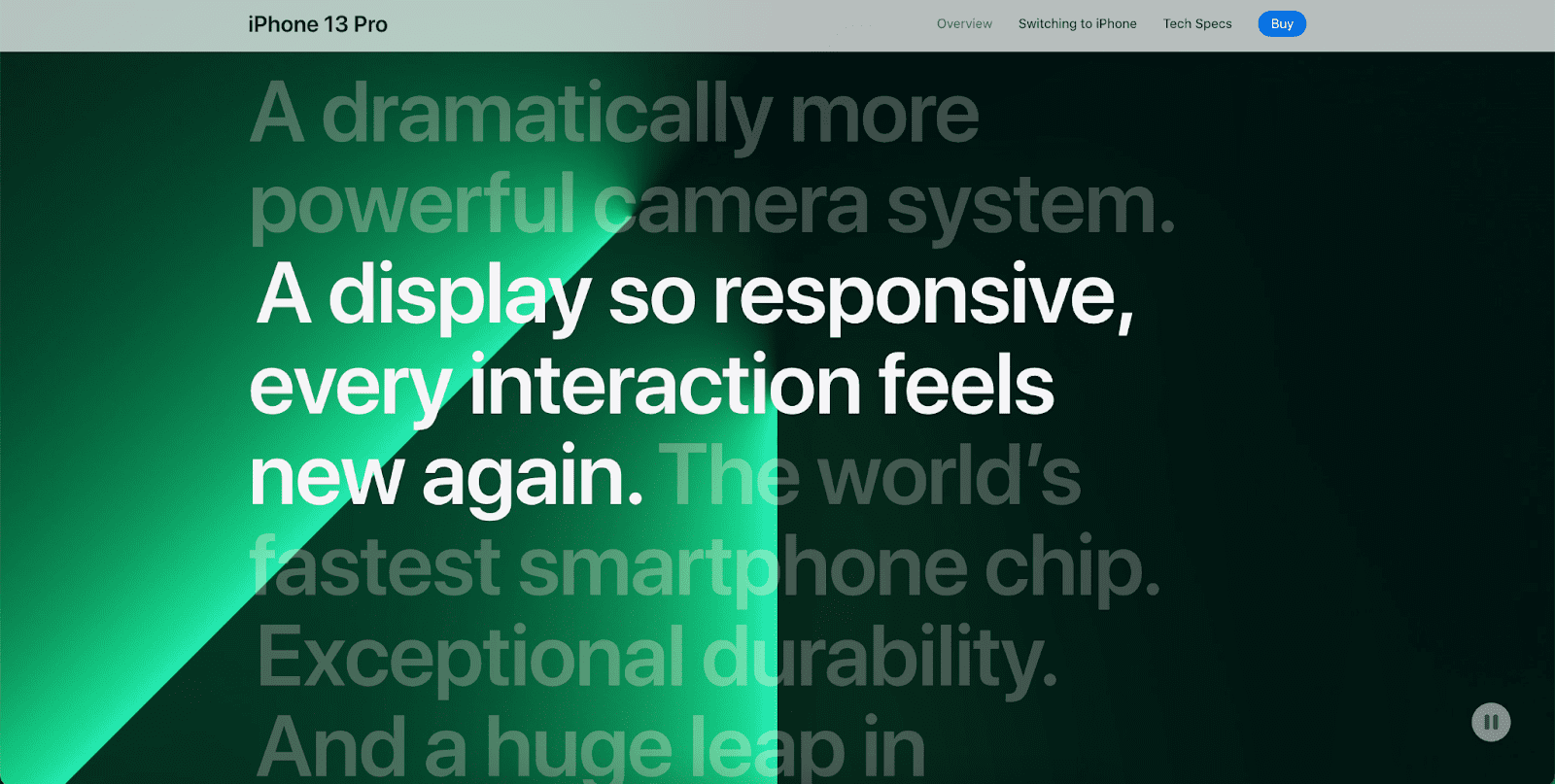
Samsung’s Product Narrative
Samsung is Apple’s bigger competitor when it comes to Android phones. This may be because their narratives touch on different aspects. While Apple tech becomes a part of its owners’ lifestyles, Samsung bets on how particular features can enhance daily activities.
Take Galaxy S22 Ultra, for example. The colors enhance the device’s style, the 4NM processor—whatever that is, it sounds cool—is the fastest one you can get in Galaxy phones, and the brightest display improves your experience on a bright day.
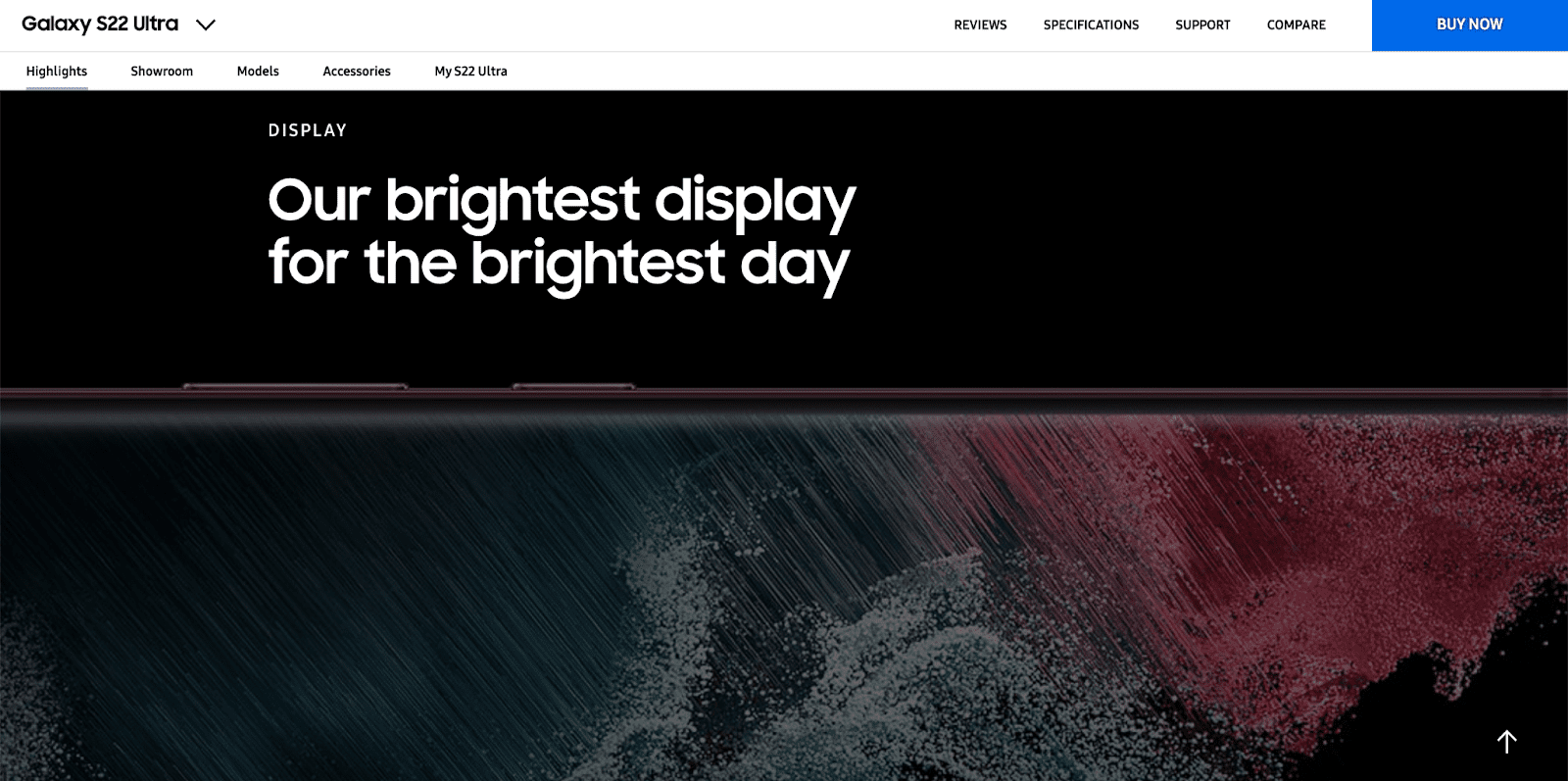
Product Story Or Product Narrative?
Story and narrative are two sides of the same coin. Both create something relatable a customer can feel towards an item, but there are cases where one is more appropriate than the other.
For example, if your eCommerce brand offers a relatively small selection of items like Apple and Samsung Galaxy, a narrative makes sense. But not if you offer thousands of items that will cater to different demographics and lifestyles. In this case, creating separate stories is more appropriate.
Let’s further focus on developing eCommerce fiction.
Product Story Elements
There are certain elements that make up a plot in eCommerce. Here are the key ones you should use when developing yours:
- Visual content – image-based material that shows an item from different angles, such as a photoset or videos of its use. It could be enhanced with interactive content; for example, if a pair of shoes come in different colors, the photos could change depending on which color a customer chooses.
- Other rich content – this is information that provides a fuller image of an item, such as banners with branded slogans, 360-degree images, and animations and certification. You can use tools like Amazon’s A+ Content to enrich catalog pages.
- Product descriptions – information about an item that explains its value for the right customer, such as the merch and brand name, and how it functions. It could be enhanced with real examples and relatable characters that your brand uses in its messages.
- Product attributes – features that describe a product, such as technical specifications, size and weight, the material it’s made of, and its source. Ones that accentuate an item’s presentation, packaging, and aesthetic appeal can make a difference.
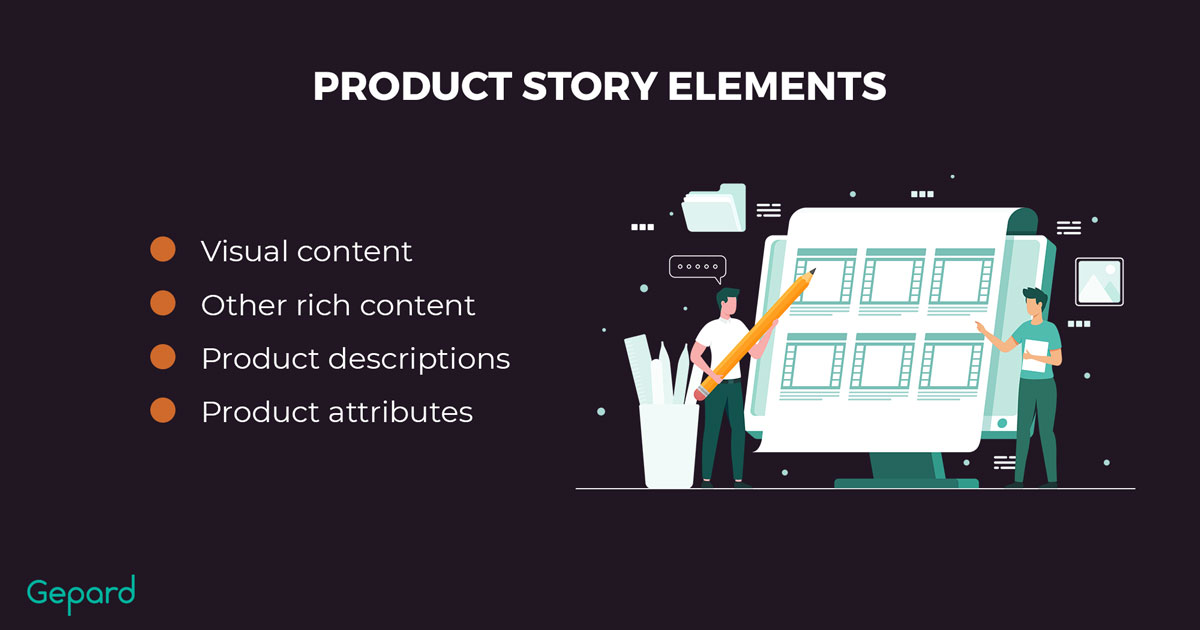
5 eCommerce Product Stories Best Practices
How do you represent an item of clothing or a piece of tech using the key elements mentioned above? Let’s explore some of the best practices that will help you implement product stories.
1. Attract Attention With The Outstanding Visual Story
Most people would notice an image or video before reading what it’s about. In fact, 93% of communication is visual. This doesn’t mean you should skip on text but including graphics increases the desirability of your content by 80%.
Visual content is not something customers can ignore because it triggers brain activity. But grabbing attention with something to watch doesn’t constitute a sale. So what should this content be like?
Showcasing your wares in the right manner visually requires a deep understanding of your target audience. Let’s illustrate some product story ideas using jewelry as an example.
Say you offer silver cuffs for women. Showing photos of them from different angles is useful from a technical aspect – what they look like. But such images don’t offer a connection to wearing these cuffs. A step up from that would be a photoset with a model, but the resulting images should also have a plot:
- Who is the person wearing them?
- What is she like?
- What’s her daily routine?
- What are her life values?
Answering questions like these will help you build a visual account.
Read more about the importance of visual content:
2. Show How Your Product Solves A Customer’s Issue
This practice is also heavily based on customer research. You need to know a lot about their lifestyle to present goods in a way that shows their value to the people it’s intended for like in any fictional account. Literature always paints a hero, highlights their struggles, and shows how the hero overcomes them.
For example, a dishwasher saves time that can be spent on other types of housework or instead on resting and spending time with pets. It also uses less water than most people need to wash up manually, meaning it saves resources. This can interest either people who want to reduce water wasting or their bills.
But what kind of issues is your audience most interested in solving? They will dictate what you should focus on first.
Once you define what problems are a priority, visualize how your customers can deal with them using your merchandise. This will help translate the process into proper titles, descriptions, and other details that complete a scenario.
3. Showcase The Comprehensive Product Attributes Set
Following the market research, you’ll have an array of customer needs. And this defines the set of attributes you need to properly describe each item in your catalog.
Let’s return to the dishwasher example. If your target audience is eco-focused, they will be interested in features that support this movement, such as power and water consumption. If they are more interested in fitting the appliance into the interior, it’s likely that attributes describing the style, color, and size will be in priority.
Make sure that customers can see the more relevant attributes first. Since attracting attention as soon as possible is a valid goal, highlight the information that would touch the audience that you have.
4. Write Immersive Product Descriptions
There are stories that have an interesting plot, but the language they’re written in isn’t engaging. You might be interested in reading till the end, yet it’s a bit of a struggle. In the case of eCommerce, you’re probably curious about an item just because you need it, but why should you buy model A and not model B?
The above-mentioned pair of Nike shoes could help you with this point.
Right from the start of the description, you’ll meet the hero of the story: “When running becomes a daily habit, stability and comfort are crucial.” This is about you – a person who started running and already knows that the two features are a guarantee that you will get out of the house.
It also uses descriptors, such as “lightweight, breathable and durable” that create emotional engagement. You want to feel this and you hope that the shoes will give you this feeling.
The key outtake here is that your fiction should be interesting and relatable – make the customer want to be a part of the narrative.
5. Give An Opportunity To Leave A Review And View Other Customers’ Opinions
Reviews are an extension of the story that allows it to live – it’s social proof. Customers often share their experience using a product, including visual materials, such as photos of wearing an item of clothing or a video of unpacking and powering on a smartphone.
You can have publicly available sections on your web store where customers can write a review or a question and upload visual media. These small individual stories add up to a grander narrative, supporting it with real events.
This can be encouraged with discounts or special offers. For example, if a customer goes into the trouble of filming a recipe using the new blender they bought from you, it may well deserve a discount for future purchases in the same category.
Another, or an additional option, is to create a hashtag by which people could share reviews of what they bought from your store. This provides room for more creativity in how an item is portrayed. And also other customers can check out the posts following the hashtag.
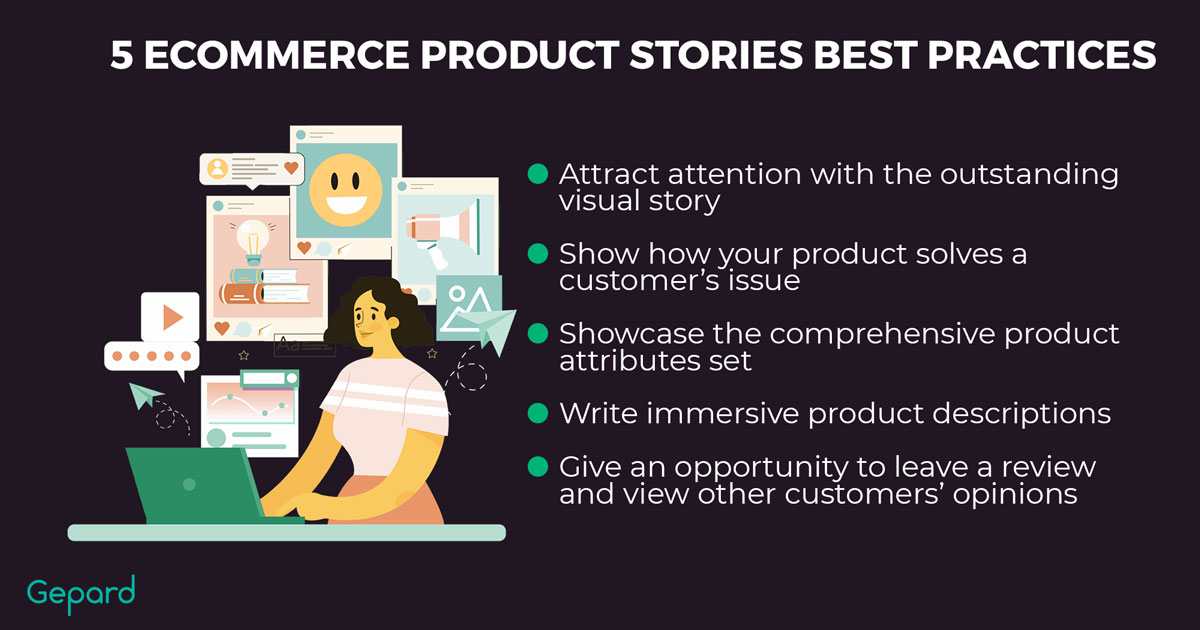
How To Enhance Product Stories With PIM Solution
A PIM software solution is short for product information management, but what does it have to do with eCommerce stories? It provides a single source of truth for collecting, managing, and distributing most of its key elements.
Let’s see how exactly you can benefit from such software.
Optimize User Experience With Retailer-Specific Content
Retailer-specific content is the data about a product that is adapted to the requirements of the eCommerce platform where it is distributed. A solution, such as Gepard PIM, supports a variety of retailers and marketplaces, so you don’t need to customize the information to each platform.
For example, Amazon has its own taxonomy. If you were to transfer your catalog there by hand, it would take quite a lot of time to change your data to fit their template structure. Instead, the tool can do this alteration automatically and, hence, reduce the time to market.
Validate Product Data
Data validation is essential for making sure that none is missing any fields or attributes. It’s a tool that analyzes descriptions and provides reports about their consistency.
If you did the same thing manually, you would spend 75% more time than the automatic process and there could still be mistakes left. Instead, you get error-free data that you can send to a retailer or distribute straight to your eCommerce platform.
Read more about product data validation:
Handle PXM (Product Experience Management) With Gepard PIM Solution – Digital Shelf Analytics
Flawless synchronization between your database and content providers is a great expectation, but it’s not the case in reality. Digital shelf analytics integrated into Gepard PIM, however, can help you improve PXM. Here are a few of its capabilities:
- Tracking syndicated data visibility and presence;
- Checking data for accuracy and transparency to ensure that customers have the latest information about your selection;
- Helping generate complete descriptions that drive sales.
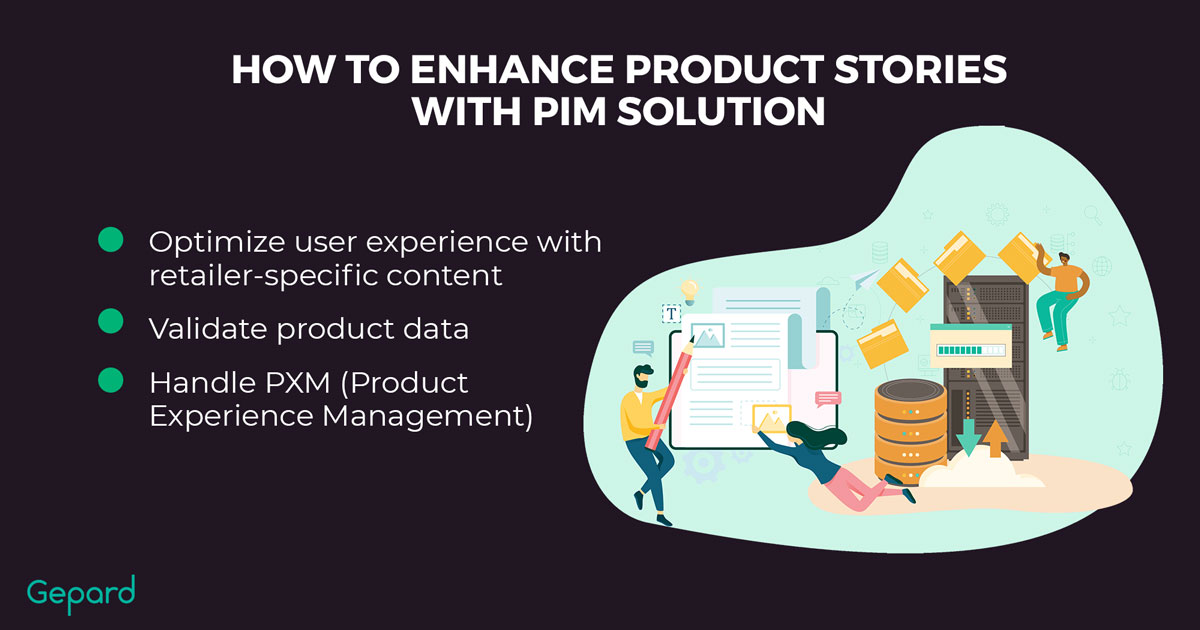
Product Story FAQ
How To Tell A Story When Creating A Product?
Start with marketing research. Learning everything possible about your customers will help you fit them into a scenario as heroes that see the value of a product and the result of its use. Taking from there, consider the following suggestions:
- Don’t skip on the basic structure – introduction, body, conclusion.
- Define what your main character (customer) is like, and what challenges they are facing.
- Describe how the main character will overcome the challenges using your product.
- Personalize your anecdotes to reflect past customer experiences.
- Define what attributes will help you tell the story.
Why Tell A Story When Selling A Product?
Because it humanizes your sales, builds trust between an eCommerce brand and a customer, and creates emotional engagement through visual and textual content. A good tale will show customers the personal value of a product in a way that simply reciting features won’t manage. It supports a purchasing decision, meanwhile, raw facts can’t do that for most people.
How A Story For A Product Is Helpful?
It’s a communication device that helps build a lasting connection. What are you more likely to remember without extra effort, the name of a character from your favorite TV show or a historical event? Probably the former since they’re part of a storyline, not a pure fact.
eCommerce fiction is more valuable and memorable than a cold description of an item’s capabilities.
Implementing Product Stories Into Practice
Product stories and narratives go hand in hand and are often confused. Simply put, the former represents each product or collection thereof in a more engaging way, and the latter forms a connection between the stories and your whole brand.
When creating product pages, it’s essential to find a balance between the two, so your target audience can find value in using the items you sell.
A key outtake is that working with product stories and narratives creates a lot of data that can only serve its purpose when it’s easy to manage. A good way to do that is by using PIM solutions.
Gepard PIM can help you create, enrich, and manage data. It can also help you monitor the information for a seamless PXM and make sure that your customers are up-to-date with the latest data. Want to try how all this can improve your business or find out more about Gepard PIM? Schedule a demo.








